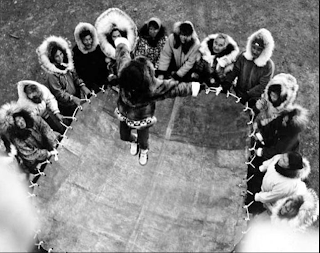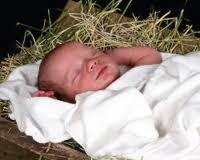Pulling Together
After arriving in Kaktovik on Friday I learned that I will
not be in town for the Nalukataq festival after all. Although I was told the Nalukataq would be held this week, I
was not told a day. The plan now
is to hold it the day I leave, which is a definite disappointment. Still, I find myself thinking about
past Nalukataqs, and how they continue to symbolize for me so much about
healthy relationships.
For instance, one of the most important aspects of the
blanket toss part of Nalukataq, is the teamwork that goes into it. The blanket, itself, is made from split
ugruk hide (bearded seal), which
requires skilled craftswomen to make (splitting the hide has traditionally been
women’s work). Around the edges of
the blanket are dozens of rope handles.
It takes a community to make the blanket, and to wield it. I love this
about the blanket toss.
The pictures I have for the blanket toss don’t really show
the handles. This one from the web
does show the handles, though the communities now use much larger blankets for
safety. If the either the jumper
or the people holding the handles are not highly skilled, someone can fly off
at an angle. At such times a
larger blanket is better.
Indeed, the first time I came to Kaktovik in 1978 the wind
was blowing. When it was my turn
on the blanket the wind blew the captain’s words away. When he said, “Atausiq, malguq, piŋasut
(one, two, three) pull!” only half the people heard him and obeyed. The other half heard nothing and did
nothing. I soon found myself
launched at an oblique angle, beyond the blanket and over the gravel.
At that point the Rev. Isaac Akootchook ran backward under
me, keeping his eye on me just like a center fielder chasing a fly ball, and
caught me, injuring his knee in the process. Yesterday, I visited Isaac, now 91
years old. I am happy to say his
knee healed up well, and he is doing well. That incident illustrates, however,
that community takes seriously the responsibility for keeping the individual
jumper safe.
I was grateful for Isaac’s courageous action then, and I am
grateful for that teaching now. If
humanity is to live well with the earth, we absolutely must develop strong and
healthy social relationships.
Since that time, the blanket toss has illustrated for me two qualities
that must be included in any healthy sense of community.
Before telling you the first lesson, you need to know that
being on the blanket has always been a thrill for me. When I was a kid, I learned to do kicks and flips on the
blanket. It is pure joy!
But for me, as an individual, I had to be part of a whole
community to develop the skill and to thrill in the experience of it all. I had to take my time pulling on the
rope, and I had to learn how we can work together to keep the jumper safe. Indeed, I remember trying to do it in
as a boy scout, without traditional elders present, and someone got a
concussion when they fell off!
The first lesson, then, is that the whole community is
important. Every handle needs
someone pulling on it just to provide enough power without wearing anyone
out. And every handle needs
someone on it to fill the gaps where an out-of-control jumper can be caught. The blanket is only possible as a
community event.
Second, the individual is important to the whole
community. When the wind gusted
unusually, so the community did not function together as they should, Isaac
made an extraordinary effort to keep me safe. Putting himself at risk, he caught me. The community is important, but so is
the individual. Indeed,
extraordinary effort and taking risks is sometimes essential to care for
individuals in the community.
And this is the interesting paradox of healthy
relationships. Building up the
whole community, which means letting go of selfishness to work as a team, is
essential if we are to build health into our communities. Further, only functional communities
make it possible for the individual to develop the skills and experience the
thrill of full life, which is only possible when we live it together. Yet, the individual within the
community is so important that we must be willing to love the particular
person, and to take courageous risks on behalf of particular persons, if the
community is to build healthy bonds and remain strong.
This is probably enough for one blog. But I do believe that meditating on the
qualities of healthy community is essential if we are to build a sustainable
future. Cindee and I are living in
the bioshelter, but we truly are trying to do so as a part of a community. We invite neighbors to our home, and we
participate in some of the efforts our neighbors make to build relationships in
our neighborhood, because we know that we live better in community rather than
isolation.
In fact, I originally thought we would try to learn a lot,
living in our bioshelter, so we would have a lot to teach others. What I have discovered is that living
in the bioshelter gets other people talking about their own learnings, and
their own efforts on behalf of the planet. It is amazing to learn from other people’s experiences, and
to share our experiences in return.
It turns out that there is so much more to life when we share our
experiences, and look for opportunities to join our efforts.
This, it turns out, is also Jesus’ teaching. Americans sometimes miss the import of
his words, because we are culturally prejudiced against thinking of ourselves
as sheep. Yet, when Jesus was
teaching about having life to the full, he spoke of himself as one who cares
for a herd of sheep, like the shepherd who protects them, or like the gate
through which the sheep may pass into good life together. Jesus is teaching us that there is
great value in seeing ourselves as individuals within a community, and not as
go-it-alone individuals.
At the same time, Jesus made the point that individuals are
essential. The good shepherd knows
this and is willing to leave the sheep in the safety of their numbers to chase
down and individual sheep when they get lost (Luke 15:1-7). Each individual makes a difference and
has its own influence on the community; yet, each individual also has great
value in his or her own right.
I will miss the blanket toss this week. Still, I find myself thinking about
it. I continue to wonder: how do
we use the wisdom of the ages to build healthy human communities? How do human communities live well
within the whole community of life?
I am convinced the future depends on it.
“I
have come that they may have life, and have it to the full.
“I
am the good shepherd.
The
good shepherd lays down his life for the sheep.”
Jesus,
quoted in John 10:10b-11




Comments
Post a Comment